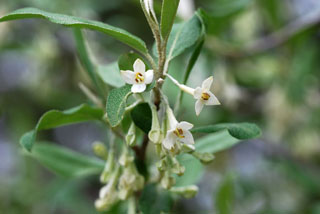AUTUMN-OLIVE
|
 |
| File Size: 48 KB |
|
|
|
Elaeagnus umbellata Thunb.
|
| Douglas County, Kansas |
| Height: Shrubs, to 16 feet |
| Family: Elaeagnaceae - Oleaster Family |
| Flowering Period: April, May |
|
| Trunks: | | Stems ascending to erect; young branches armed with thorn-like lateral branches, older branches unarmed; bark gray to reddish brown, fissures shallow, exfoliating in long strips; wood light brown, hard. | | Twigs: | | Young twigs gray to grayish brown, flexible, densely lepidote, older twigs gray to grayish brown, flexible, sparsely to densely lepidote; leaf scars half-round; buds silver-brown, ovoid, .1 to .14 inch, apex acute, densely lepidote. | | Leaves: | | Deciduous, alternate, simple; petiole 0 to .3 inch, lepidote; blade elliptic to oblanceolate or lanceolate, 1 to 4 inches long, .4 to 1 inch wide, base cuneate to rounded, margins entire, apex obtuse to acute, lower surface silver, lepidote, upper surface dark green to light green, glabrate or sparsely lepidote. | | Flowers: | | Inflorescences axillary on new growth, umbel-like clusters, (1-)2-8-flowered; peduncles absent; pedicels .08 to .24 inch. Flowers bisexual, sometimes functionally unisexual, radially symmetric; hypanthium white to yellowish white, funnelform, .28 to .3 inch; sepals 4, connate proximally, lobes white, fading yellowish white, triangular, .14 to .16 inch; petals absent; stamens 4, adnate to hypanthium, exserted; pistil 1; style .2 to .28 inch. | | Fruit: | | August-October; drupe-like achenes, red to pink at maturity, ovoid, .24 to .3 inch long, .12 to .16 inch wide, fleshy, juicy, sweet; seed 1, yellowish brown with darker longitudinal stripes, ovoid to ellipsoid, .16 to .2 inch long, .1 to .12 inch wide, slightly longitudinally ribbed. | | Habitat: | | Dry to moist forests and woodlands, sandy clearings, and disturbed areas. | | Distribution: | | East 1/3 of Kansas | | Origin: | | Naturalized | | Comments: | | Elaeagnus umbellate is native to China, Korea, and Japan. It was introduced for use in windbreaks, for soil conservation, and for its wildlife value; it spreads readily from plantings and is classified as legally noxious in four eastern states in the United States. It was first documented in the wild in Kansas in 1993 and is now found widely in forests and woodlands east of the Flint Hills. |
|
| Autumn-olive flowers |  | | 56 KB | | Douglas County, Kansas |
| | Autumn-olive leaf |  | | 52 KB | | Douglas County, Kansas |
| | Autumn-olive bark |  | | 79 KB | | Douglas County, Kansas |
| | Autumn-olive inflorescence |  | | 60 KB | | Douglas County, Kansas |
| | Autumn-olive habit |  | | 138 KB | | Douglas County, Kansas |
| | Autumn-olive habit |  | | 218 KB | | Ottawa County, Kansas |
| | Autumn-olive |  | | 145 KB | | Ottawa County, Kansas |
| | Autumn-olive twig |  | | 108 KB | | Ottawa County, Kansas |
| | Autumn-olive flowers |  | | 104 KB | | Ottawa County, Kansas |
| | Autumn-olive bark |  | | 121 KB | | Ottawa County, Kansas |
| | Autumn-olive leaf |  | | 113 KB | | Ottawa County, Kansas |
| | Autumn-olive |  | | 109 KB | | Ottawa County, Kansas |
| | | |
|
|
|